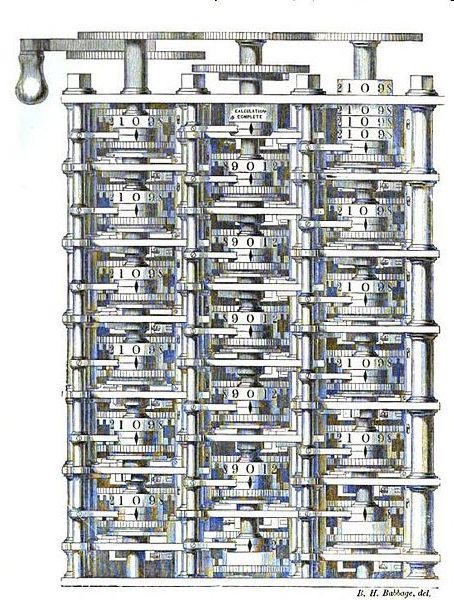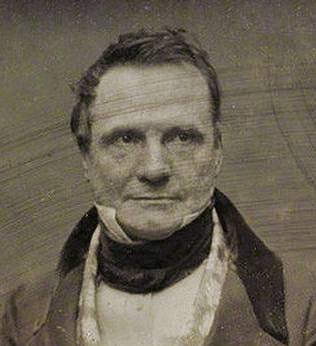| Commemorating the Birthday in 1791 of Charles Babbage |
| Written by Sue Gee | |||
| Monday, 26 December 2016 | |||
|
Today we celebrate the birth on December 26th, 1791 of Charles Babbage, the man who invented calculating machines that, although they were never realised in his lifetime, are rightly seen as the forerunners of modern programmable computers, enabling us to consider Babbage as the Father of the Computer.
Charles Babbage The son of a prosperous banker, Charles Babbage was born in London. Due to ill health he spent part of his childhood in Devon and some of his education was by private tutor. He was already self-taught in math prior to going to Cambridge to study it at age 18 and was not impressed by the standard of mathematical instruction there and received a degree without examination in 1814 although he returned there from 1828 to 1839 to occupy the Lucasian chair of mathematics, the post recently held by Stephen Hawking, To characterise Babbage as a mathematician is misleading because his interests were much more wide ranging - a polymath is closer. He was elected a Fellow of the Royal Society in 1816 and was instrumental in founding the Astronomical Society in 1820. Babbage conceived the idea of his Difference Engine in order to compute the values of polynomial functions without the need for multiplication and division. He built a small demonstration model, Difference Engine 0, in 1822 and on the strength of this was awarded the money to design and build Difference Engine No 1. This he attempted to do with the help of Joseph Clement, a skilled toolmaker and draughtsman, but to be successful he had to push the precision of the metal working of the time to its limits. Babbage was a good mechanical engineer in his own right. He used a lathe, built many test pieces on his own and studied the manufacturing methods then available to see if any could be used to mass produce the accurate parts he needed.
Difference Engine No 1 would have been 8 feet high by 7 long and 3 deep and would have weighed tons. It was never completed due to an argument over compensation to Joseph Clement due for moving his workshop to be near to Babbage stopped the project in 1833. In reality it was probably that ten years was too long to sustain such a project without results and Babbage was already thinking about his next project. It was in 1833 that Ada Lovelace first met Charles Babbage at a party attended by scientists and other luminaries. Babbage himself was famous for the soirees he held at his home and on June 17 Ada and her mother Annabella Lady Byron went to one at which Babbage gave a demonstration of the Difference Engine. Augustus De Morgan, (of De Morgan's Laws and later to become Ada's mathematics tutor to satisfy her desire to learn calculus) was with her and recorded: "While other visitors gazed at the workings of the beautiful instrument with the sort of expression, and I dare say the sort of feeling, that some savages are said to have shown on first seeing a looking-glass or hearing a gun - if indeed, they had a strong an idea of its marvelousness - Miss Byron, young as she was, understood its working, and saw the great beauty of the invention." The Difference Engine was by no means the pinnacle of Babbage's designs. This was the age of the Industrial Revolution and, inspired by the Jacquard loom that he travelled to Lyons to see in action, had plans to harness the power of steam for many different devices, the most ambitious of which was the Analytical Engine, now thought of as the greatest machine never built. While wasn't built in his lifetime, there was a partial build of it in 1910 and now an ongoing project named Plan 28, a reference to the extensive documentation left by Babbage, to build it by the 2030s, 200 years after it was originally designed. For its recent news see Plan 28 Makes Progress In Understanding Babbage's Mechanical Notation. Charles Babbage was an amazing visionary and, as Mike James writes in I Programmer's history article: [his] curse was that he was a man born before the technology needed to make his ideas a reality. We have previously speculated, see What if Babbage..?, on how contemporary technology might have been different, or at least accelerated, had he managed to complete his ambitious plans in his lifetime.
Charles Babbage, c. 1850
Last year at this time we reported on a campaign for a Lovelace & Babbage LEGO set, with models not only of Ada and Charles but extending to his pet own and the Analytical Engine. The good news is that having attracted to 10,000 votes required this has reached the stage of being considered as a commercial product.
Related ArticlesAda Lovelace, the first programmer The Greatest Machine Never Built (Video) To be informed about new articles on I Programmer, sign up for our weekly newsletter, subscribe to the RSS feed and follow us on Twitter, Facebook or Linkedin.
Comments
or email your comment to: comments@i-programmer.info <ASIN:1862078394> <ASIN:1603860924> <ASIN:0670910201> <ASIN:0262121468> <ASIN:0901805459> <ASIN:0349112398> <ASIN:0563369922> <ASIN:1783340711>
|
|||
| Last Updated ( Monday, 26 December 2016 ) |




